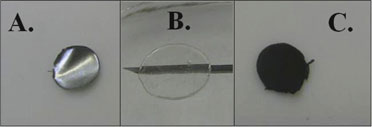Scientists from the Department of Materials Science and Technology at the US Naval Research Laboratory provide solid evidence for the existence of a path to the development of innovative and lightweight energy storage devices.

Scientists from the Department of Materials Science and Technology at the US Naval Research Laboratory provide solid evidence for the existence of a path to the development of innovative and lightweight energy storage devices. By deviating from centuries of battery cell development based on a caustic and dangerous aqueous solution, to use non-volatile, stable ionic liquids, scientists predict a variety of new types of batteries.
Instead of relying on particularly acidic electrolytes, ionic liquids are used to prepare a solid polymer electrolyte consisting of an ionic liquid and polyvinyl alcohol, and from which new types of solid-state batteries with an electric voltage of up to 1.8 volts are developed.
The unique properties of ionic liquids have encouraged the exploding interest in applications for the field of batteries. Ionic liquids are molten salts at room temperature with many important characteristics, such as: almost zero vapor pressure, non-flammability and lack of activity in a variety of industrial or electrochemical applications. "The high thermal and electrochemical stability of ionic liquids is what has encouraged the growing interest in ionic liquids for use in a variety of electrochemical processes," said Dr. Thomas Sutto. "These new types of solid-state cells mimic normal alkaline cells, but without the need for the use of conductive electrolytes."
The limitations imposed on the use of fused electrolytes often lead to serious limitations on the geometric shape of a conventional battery and the need for special fusion-resistant battery containers. The use of active ionic liquids in non-aqueous cells replaces the more dangerous alkaline electrolytes such as magnesium oxide (MgO) and zinc (Zn) found in conventional batteries.
The source of this research was discovered during normal fusion studies of various metals in ionic liquids. While working with ionic liquids based on mineral acids, such as hydrogen sulfates, the researchers found that zinc metal reacts to obtain zinc sulfate. Since the reaction is similar to the one that occurs in a zinc anode in a normal alkaline cell, the researchers conducted a series of experiments to determine how different metal oxides react in these types of ionic liquids.
The electrochemical experiments showed that not only do these active ionic liquids function as an electrolyte/separator in both solid and liquid batteries, but they also serve as reactants in the electrochemical reaction itself that occurs in the cell. Using this non-aqueous approach for primary and secondary energy sources, the batteries can be designed with common anode and cathode materials such as magnesium dioxide (MgO2), lead dioxide (PbO2) and silver oxide (AgO). The ionic liquid that was the basis of this research is 1-ethyl-3-methylimidazolium hydrogen sulfate (EMIHSO4), however, other ionic liquids such as those based on nitrate and di-hydrogen phosphate anions can also be used for the design of batteries of this type.
The use of these electrolytes presents the possibility for the development of new types of rechargeable systems that can replace the electrolytes in nickel-metal hydride (NiMH) batteries or even in conventional lead-acid batteries.

3 תגובות
This is really a revolution!
Another precedent:
First response to the article by Dr. Nachmani 🙂
Another precedent:
This is the first time it has been shown liquid which constitutes "vision solid"